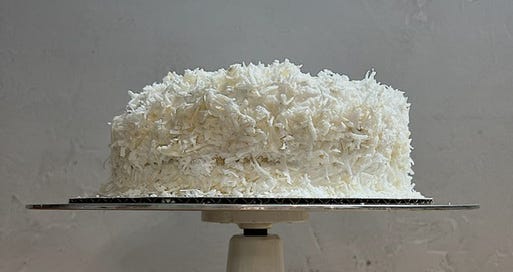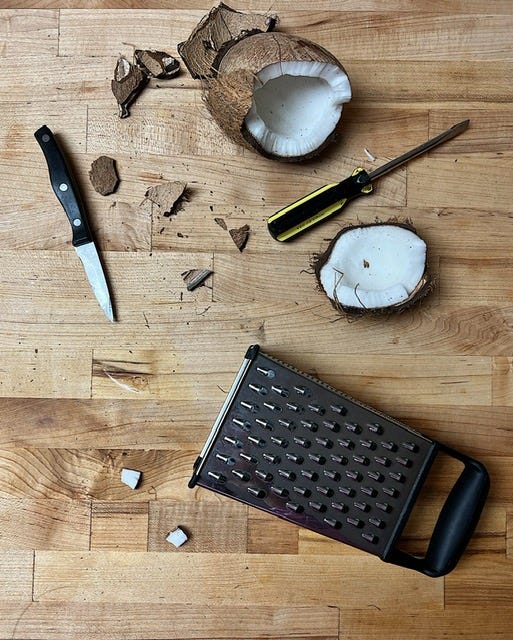A friend has a great substack about photography. He posted recently about the ways photography can support us in resisting the pressures of the attention economy. Check it out here:
As I mentioned to him in a comment, many of his points resonated for me as I relearn over and over myself how to resist (or at least enter into a conscious and more equitable relationship with) the crushing demands of our current attention economy.
One of the ways I’m doing that, now that I have no baking business always propelling me towards max efficiency, trends, one upmanship, and insta-cleverness, is by baking the recipes of craftswomen I admire, paying attention and feeling them in my body as I do so. Staying curious about the recipe as narrative, cultural history and somatic experience while resisting the desire to jump ahead to how I’d “improve” it, “adapt’ it, or stage it on social for fast consumption.
There is a slowness to this process that I am breathing into. Resistance lies here too. Slow because scratch baking requires and engages time in ways that aren’t easily accessible for me now. Slow because I’ve lost the muscle memory that makes for kitchen efficiency. I don’t entirely trust myself to eyeball measurements anymore and I’ve got to go rooting through drawers for my measuring spoons. Slow because, while the recipes are my inheritance, they are not always familiar to me.
My Great Grandmother Roxy McGoodwin (Grandma Mac) baked coconut cake every year for Easter in lamb-shaped pans. This cake was looked forward to and celebrated long before I existed. The care-full baking and presentation, the cake’s symbolic representation and its shared eating were rituals that marked a yearly cycle and connected my extended family to shared religious values and to each other. These matrinominal practices around food are beautifully ordinary, everyday ways we stay with each other. I don’t have her recipe unfortunately, but this week seemed like a good time to bake Edna Lewis’s Coconut Layer Cake with Lemon Filling in Grandma Mac’s honor. Cake as continuing bond. As Re-Memory.
One of the many reasons I love reading Lewis is also why her recipes can be challenging to work from. They captured her voice in a translational moment between the culture of oral recipe and technique transmission she likely grew up in and now. Her recipes were shared conversationally with her editor, transcribed, edited, and read kind of like descriptive prose. Experiential or cultural context adds narrative elements. So many of us are used to the culinary hand-holding of recipes constructed with handrails, warnings, prep and step-by-step directions.
Lewis’s recipe is for a sponge cake filled with a light lemon curd, covered in boiled icing and a cloud of freshly shaved coconut. Sounds easy enough but the time management cues, step-wise progression and conveniences are gone. For example, we are not told the the curd is best chilled overnight until after we are ostensibly well into the project. Ms. Lewis doesn’t share what the oven should have been preheated to until halfway into the second paragraph of cake instructions. And of course, when making the icing, we are looking for beads and threads as signs our sugar syrup is ready instead of a numerical reading on a digital candy thermometer.
I’m committing to Lewis’s recipe though, I remind myself, because I want to see what I learn about time and through my five senses as I try to bake and ‘think in food’ as she did. I commit to the fresh coconut she tells me I need because I trust her. I have learned so much from her about flavor, freshness and quality and the way these qualities should be in right relationship with sustainable, practical expediency. What is at hand? What have you grown? What is in season?
She reminds me that coconuts were common in the south during the winter months (and subtly links that “seasonality” to centuries-old extractive capitalist shipping routes woven throughout the circum-Caribbean, by the way). She offers advice:
“when you buy a coconut, always select one that feels heavy and that obviously has water inside it. Dry coconuts may not be good or have much flavor. To be on the safe side, I suggest buying two coconuts in case one is bad; it is sometimes hard to judge until you have opened them.”
But here we have a rare example of Lewisonian advice I will never take again. Whole, fresh coconuts suck. The hammer, the awl, the bag I ended up putting the flipping coconut in so that I could go outside and bang it against the brick of my own house, the peeler I nearly broke in two, the knuckles I accidentally grated along with the flipping coconut, the time I will never get back—all are outside of the frame of the process photo above. I’ll be buying pre-shredded coconut bagged for my convenience like the modern woman I am from now on, thank you very much.
Plenty of other mistakes were made. I accidentally folded all of the egg whites into the cake batter instead of leaving one for the icing. I failed utterly at reading the threads and balls even though Lewis describes them about eighteen times and ended up with a very grainy boiled icing. Because the curd was my only success and delicious, even without all the extra butter I usually add to my own, I overfilled the cake even though I know better. This sent layers sliding in each of the cardinal directions. There has been some MacGyver-level troubleshooting just to be able to get a picture of the damn thing. Alas, the thing was still delicious.
Apart from the Great Lesson of the Coconut, I think what I learned from Ms. Lewis this time, with her Lemon-filled coconut cake, can be summed up in an almost koan-like phrase she inserts after advising me to blend the cake mixture until it becomes light and fluffy:
“Do not be impatient.”
Do not be impatient. Indeed. Like my Grandma Mac might have offered, and in resistance to the empty quest for instant gratification and insta-success, I can try again next year.
***
What did you bake or make for Easter, Passover, Holi, Basanth, the equinox, the first appearance of spring ephemerals, or simply in celebration of the way each and every year about this time, as Mary Oliver would put it, “the world comes back wet and beautiful”? xx







